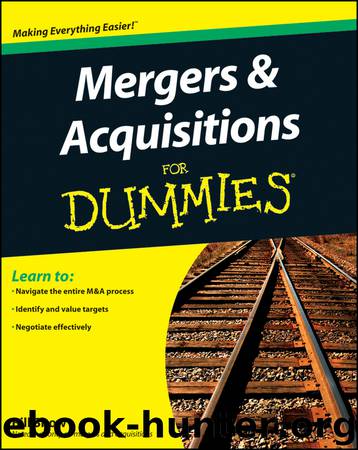Mergers and Acquisitions For Dummies by Bill Snow

Author:Bill Snow
Language: eng
Format: epub, mobi
Publisher: John Wiley & Sons, Ltd.
Published: 2011-04-03T16:00:00+00:00
Financial projections
Ideally, an offering document should have five years of projections. I know that’s a lot of work, especially when projections are taken with a grain of salt, but Buyer should be able to get a good sense of where you think the company is headed.
Your projections should include a narrative explaining the assumptions you used to create them. For example, explain your rationale for revenue increases and how expenses are related to those revenues. Achieving the projected numbers is imperative, so you’re much better off to project low growth and beat that projection than to project rapid growth and fall short. You’re sure to create problems for yourself if you pad your projections to an unobtainable level. Not achieving those higher projections often leads to a lower sale price. Plus, Buyers are on the lookout for overly rosy projections and may discount projections that the historical financials don’t support. (See the preceding section for more on historical financials.)
Another important figure in the projections is CAPEX. CAPEX (short for capital expenditures) occur when a company makes some sort of investment in itself. Instead of immediately expensing the expenditure, thus reducing profits by the full amount of the investment, a company may be able to capitalize the expenditure and write off the expense over a period of time. Examples of CAPEX include anything that will be used for a long period of time: computers, software, furniture, improvements to the facilities, manufacturing equipment, and so on.
For example, say a company pays $1 million for a piece of equipment with an expected useful life of ten years. Writing off the full cost of the equipment in year one doesn’t make sense because the equipment will be used for nine more years. Instead, the company writes off the amount of the equipment used each year, or $100,000 per year. This write-off is called depreciation.
Because annual capital expenditures are not captured in the venerable EBITDA calculation, Buyers should take a close look at a company’s CAPEX needs to fully understand the true cash flow of the business.
Balance sheet basics
One of the most important figures from Seller’s balance sheet is the company’s working capital. For the purposes of M&A, working capital commonly means current assets minus current liabilities. Typically,
Current assets = accounts receivable + inventory + prepaid expenses
Current liabilities = accounts payable + short-term debt + current portion of long-term debt + accrued (unpaid) expenses
For the purposes of M&A, you don’t include cash and equivalents in this calculation. However, for accounting purposes, you do include them.
Working capital is important because it represents the liquidity of the company. All current assets should be convertible into cash within 30 days, and all current liabilities should be able to be paid within 30 days.
Buyers, eye the balance sheet carefully to see whether the company you’re looking to acquire is sufficiently undercapitalized, has a reasonable reserve against bad (uncollectable) accounts, and has its current liabilities all within terms. If any of these items are remiss, you may be taking over financial trouble.
Download
Mergers and Acquisitions For Dummies by Bill Snow.mobi
This site does not store any files on its server. We only index and link to content provided by other sites. Please contact the content providers to delete copyright contents if any and email us, we'll remove relevant links or contents immediately.
Hit Refresh by Satya Nadella(8989)
The Compound Effect by Darren Hardy(8724)
Change Your Questions, Change Your Life by Marilee Adams(7554)
Nudge - Improving Decisions about Health, Wealth, and Happiness by Thaler Sunstein(7453)
The Black Swan by Nassim Nicholas Taleb(6940)
Deep Work by Cal Newport(6810)
Daring Greatly by Brene Brown(6363)
Rich Dad Poor Dad by Robert T. Kiyosaki(6309)
Principles: Life and Work by Ray Dalio(6114)
Man-made Catastrophes and Risk Information Concealment by Dmitry Chernov & Didier Sornette(5872)
Playing to Win_ How Strategy Really Works by A.G. Lafley & Roger L. Martin(5736)
Digital Minimalism by Cal Newport;(5578)
Big Magic: Creative Living Beyond Fear by Elizabeth Gilbert(5549)
The Myth of the Strong Leader by Archie Brown(5368)
The Slight Edge by Jeff Olson(5314)
Discipline Equals Freedom by Jocko Willink(5234)
The Motivation Myth by Jeff Haden(5118)
Stone's Rules by Roger Stone(4986)
The Laws of Human Nature by Robert Greene(4920)
